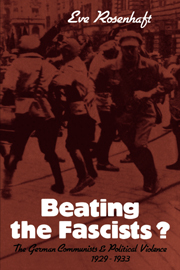Book contents
- Frontmatter
- Contents
- Preface
- List of abbreviations
- Map 1 Greater Berlin 1930
- Map 2 Central Berlin 1930
- 1 Introduction: Social crisis, radical politics and organized violence in Weimar Germany
- 2 The Party, the neighbourhood and the uses of violence in the ‘Third Period’
- 3 Defining the enemy: The wehrhafter Kampf against the SA in theory and propaganda
- 4 Organizing the wehrhafter Kampf: The Communist defence formations
- 5 Between ‘individual terror’ and ‘mass terror’: The campaign against the SA-taverns, 1931
- 6 The shape of violence in the neighbourhoods
- 7 Who were the streetfighters?
- 8 Conclusion: Communist politics in the Weimar Republic
- A note on sources
- Notes
- Bibliography
- Index
3 - Defining the enemy: The wehrhafter Kampf against the SA in theory and propaganda
Published online by Cambridge University Press: 05 March 2012
- Frontmatter
- Contents
- Preface
- List of abbreviations
- Map 1 Greater Berlin 1930
- Map 2 Central Berlin 1930
- 1 Introduction: Social crisis, radical politics and organized violence in Weimar Germany
- 2 The Party, the neighbourhood and the uses of violence in the ‘Third Period’
- 3 Defining the enemy: The wehrhafter Kampf against the SA in theory and propaganda
- 4 Organizing the wehrhafter Kampf: The Communist defence formations
- 5 Between ‘individual terror’ and ‘mass terror’: The campaign against the SA-taverns, 1931
- 6 The shape of violence in the neighbourhoods
- 7 Who were the streetfighters?
- 8 Conclusion: Communist politics in the Weimar Republic
- A note on sources
- Notes
- Bibliography
- Index
Summary
By the time the National Socialist Party obtruded itself on the notice of the Communist policy-makers, the aims and tactics of German Communism in the ‘Third Period’ had already been laid down. Defining the threat that National Socialism posed to the Communist Party and the working class and developing a comprehensive policy of response to that threat thus demanded that a place be found for the NSDAP in the existing KPD analysis of the political prospect. This did not prove difficult. In 1932 Werner Hirsch, in what may be described as the first account of National Socialism and fascism that was both authoritative and comprehensive, described the NSDAP as ‘the true [eigentliche] fascist mass-party’, but well before that the Nazis had taken their place in the broad fascist front envisaged by the Comintern. It is possible to identify a broadly consistent KPD policy towards the National Socialists, appearing late in 1929 and persisting even into 1933, which reflected the tactical preoccupations of the Party.
In the context of the KPD's general line on fascism, the question of the use of violence was raised as a question of the appropriate response to the violence of the Nazis, and the answer was dictated by the pre-existing formulas for mobilizing the 'masses’. As the KPD policy-makers saw it the violence of the SA had three important functions. Repeated physical attacks were aimed at undermining the fighting spirit of the working-class movement – in the interests of though not demonstrably by the controllers of the capitalist system and the bourgeois state.
- Type
- Chapter
- Information
- Beating the Fascists?The German Communists and Political Violence 1929–1933, pp. 57 - 87Publisher: Cambridge University PressPrint publication year: 1983



